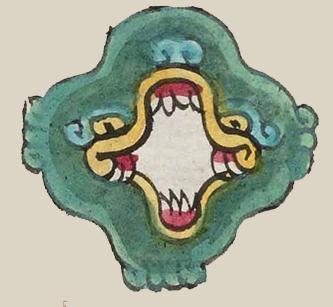oztotl (Mdz10v)
This element of a cave (oztotl) is part of the compound glyph for the place name Oztoticpac. The cave doubles as an animal head (earth monster?) with open jaws, suggesting that to enter the cave one would be walking into the mouth of the animal. The animal head, facing us in this example, is primarily green, with a turquoise above and behind the eye and a turquoise nose. The mouth is outlined in yellow/gold and the eyes are the same gold. The teeth are white, and the gums are red. The bottom of the chin and the sides of the face have curly features, reminiscent of rocks (tetl) and hills or mountains (tepetl). Another frontal oztotl appears on this same page of the Codex Mendoza. It is very similar in its details, except that the nose is simplified and the top of the head also has the rocky outcroppings.
Stephanie Wood
The curly designs located approximately where the animal would have ears and chin borrow from the symbol for tetl (rock, stone), suggesting that the cave is located in a rocky outcropping, helping us distinguish this sign from just an animal head. The nose, eyes, and corners of the mouth also possibly convey something of the curliness of the tetl) and tepetl) sign. Also, note the quadripartite (or quincunx) shape of the head, which seems to connect it to the four directions on earth and possibly the axis that goes from the celestial realm to the underworld, with the opening to the cave providing access to the underworld. Openings to caves also had associations with the human mouths and the vagina and the uterus of a woman in some Aztec symbolism (see, for example, the quote from Book 6 of the Florentine Codex and the quote from the Historia Tolteca-Chichimeca, referring to Chicomoztoc, in our online Nahuatl Dictionary, under the word oztotl). But, here, the animal-like head is nevertheless very clear, perhaps linking caverns to animals. Andrea J. Stone also mentions the "personification" of caves and the fact that the term oztotl is an animate noun in Nahuatl (see Images from the Underworld, 2010, 21).
Stephanie Wood
c. 1541, or by 1553 at the latest
Stephanie Wood
Joseph Scott and Crystal Boulton-Scott made the SVG.
caves, animals, underworld

ozto(tl), cave, https://nahuatl.wired-humanities.org/content/oztotl
la cueva (la entrada)
Stephanie Wood
Codex Mendoza folio 10 verso, https://digital.bodleian.ox.ac.uk/objects/2fea788e-2aa2-4f08-b6d9-648c00..., image 31 of 188.
The Bodleian Libraries, University of Oxford, hold the original manuscript, the MS. Arch. Selden. A. 1. This image is published here under the UK Creative Commons, “Attribution-NonCommercial-ShareAlike 3.0 License” (CC-BY-NC-SA 3.0).



